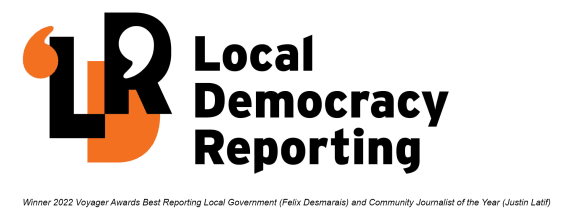
Signs as part of a protest at Rotorua's Lake Rotokākahi, on 31 January, 2024. Photo: LDR/ The Daily Post - Andrew Warner
A Rotorua iwi board is protesting the laying of a sewerage pipeline near a sacred lake which they fear is disturbing their tūpuna (ancestors) who are buried in the area.
The Rotokākahi Board of Control says the sewerage pipeline raises the risk of pollution entering Lake Rotokākahi (also known as the Green Lake) and that the board was not consulted about the works.

However, the council says the plan has had "extensive community consideration over many years" with input from iwi and hapū. It says it has done what it can to mitigate risks - both to the lake and archeologically.
Construction of Rotorua Lakes Council's Tarawera Sewerage Scheme began in April last year and involves laying pipes and installing pump stations. When completed, 446 properties will be connected to the new network.
The project aims to improve water quality at Lake Tarawera and follows rules introduced in 2017 to phase out septic tanks in the area.
Lake Rotokākahi, in the Tūhourangi rohe, is situated near the roading corridor the pipeline follows.
It is a tapu (sacred) lake, which can only be accessed by the iwi that owns it and is overseen by the Rotokākahi Board of Control.

Lake Rotokakihi Trustee Peter Moke. Photo: Andrew warner
Co-chairman Peter Moke organised a protest at the lake's edge on Tuesday and Wednesday to stop pipes being laid by the lakeside on Tarawera Rd.
There were about 15 protesters by mid-morning. The Tino Rangatiratanga flag flew by the roadside and signs read phrases like: "Stop sh*t pipe."
Speaking to Local Democracy Reporting by the water, Moke said he was a kaitiaki (guardian) of the lake.
The trust was concerned the pipes would be close to the water's edge, and if the pipes failed at a certain join, the sewage could flow into Te Wairoa Stream and the sacred lake, he said.
He believed the pipes could be laid elsewhere.
"It's a significant historical site all through here."
Moke said to his knowledge no archeologist had been present during the works near the lake.
In his opinion: (They) "were just drilling through and sucking up stuff, our tūpuna (ancestors) underneath the ground. The buried village is just there."
During the 1886 Mt Tarawera eruption, more than 120 people died under the ash and mud that rained down on the district - entire villages disappeared forever.
In regards to the current works: "We didn't give consent to any of this," Moke said.
Moke said the trust was not contacted about the scheme until November last year and he said the council told him the trust would be contacted again, but was not.
"We wanted another hui."
Moke said by the time the trust was contacted the council put it in a position where it "couldn't really say much because it already had the go-ahead."
By the end of Tuesday, Moke said about 50 people attended the protest throughout the day.
The council's infrastructure and environment group manager Stavros Michael responded to Moke's comments, and "acknowledge the views expressed".
"Without the scheme, human wastewater will continue to leach through groundwater into Lake Tarawera and all parties agree that this must stop."
Michael said it was a result of "extensive community consideration over many years", including discussion with, and input from, iwi and hapū.
"A community steering group that included iwi and Māori landowners and included at least one member of the Rotokākahi Board of Control, worked collaboratively to consider a number of options and, in late 2018, arrived at a preferred option."
This option was approved by the 2020 council, he said.
"We are now at a point where the project is well underway, with much of the construction already completed.
"Furthermore, [the] council is bound by legally binding commitments. Having progressed this far, we cannot now re-design or re-route the project, changing decisions made some four years ago."
Delays would impact the health of Lake Tarawera and cost the community, he said.
Michael said the council responded to the board's concerns and offered to show them the system design and protections it incorporated in the network to minimise risk.
"Arriving at the preferred option followed careful consideration of technical, cultural, financial and planning factors."
The pipeline the board was opposed to ran on the opposite side of the road to the lake, he said - about 100 metres.
Options such as a treatment plant in the Tarawera catchment and alternate routes for the pipeline were found to be unfeasible.
The scheme was included in the 2021-2031 Long-Term Plan following public consultation.
"The scheme does not cross the lake or the land owned by the board of control, and has been designed to a high standard to ensure the safety of the lake."
Michael said the council is legally able to install water, stormwater and wastewater pipelines within the existing road corridors.
"Regarding any potential archeological findings - as with any such project, there are strict protocols in place that include an immediate stop to works if anything is found and having this investigated by relevant experts.
Cultural monitors have been appointed by local mana whenua. Nothing has to date been found."
Tūhourangi Tribal Authority was approached for comment.
LDR is local body journalism co-funded by RNZ and NZ On Air.




